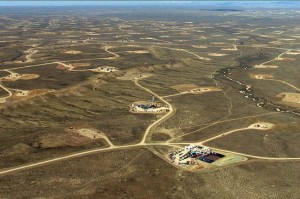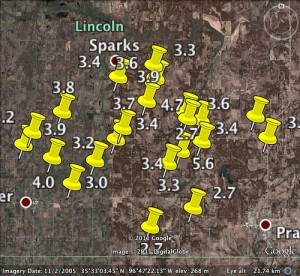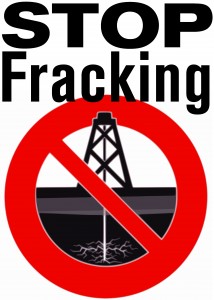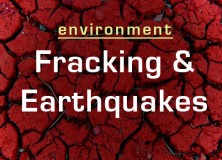
Fracking wells are being drilled in many states throughout the country – not just Pennsylvania. If you’re happy with fracking because it saves you a few dollars on your gas bill, consider how much you’ll be saving when you need to buy your drinking water, or repair your home after an earthquake.
Maybe it will cost your children and their children when they’ve spent a lifetime drinking the water contaminated by the wells.
Fracking industry spends billions lying to the public.
Fracking involves using millions of gallons of water laced with sand and toxic chemicals, there are over 632 different chemicals used in fracking. They inject these liquids deep underneath the ground to break apart shale formations holding oil and natural gas. And fracking has been associated with air pollution, water contamination, water depletion, earthquakes, and of course climate change, you know, across the US and internationally. That is why you are seeing countries like France having a ban on fracking, states like New York currently having moratorium on fracking, and movements across the world seeking a ban on fracking.
Oil and gas companies have spent billions of dollars on selling us the story about how fracking is safe and the reality is quite different. Here in the US we have communities from Wyoming to Texas and Pennsylvania where people literally cannot drink their water and we have earthquakes in places like Oklahoma and Arkansas that are not prone to earthquakes, from the underground injection of fracking wells.
Particularly here in the US, oil and gas companies give a lot of money to people running for political office. The Western States Petroleum Association took about a dozen lawmakers out for a $13,000 dinner. Our own Governor Corbett has received more than $1.2 million from the oil and gas industry to help him get re-elected.
However, what we are also seeing is the power of people in the grassroots across this country and others really rising up. Last month a law that would have prevented communities from banning fracking was struck down by the courts.
Recently in Colorado, for example, which is extremely fracked, probably the most-fracked state in the country, we saw four communities pass moratoriums or bans on fracking in the last election. We are seeing Native American communities rising up and communities in France, in New York, and California fighting for bans or moratorium on fracking.
Ultimately, continued grassroots efforts by communities and bloggers can overtake the power of oil and gas, but oil and gas are certainly putting up a good fight.
Producer of “Gasland” Interview
Pennsylvanians should be aware of what is happening in other states that have welcomed fracking.
While Pennsylvanians become aware of the ecological damage being done by fracking drilling in the Marcellus Shale Region, there is increasing evidence that fracking for natural gas in the Barnett Shale Region of Texas may bode of dire consequences that Pennsylvania can expect.
In a small patch northwest of Fort Worth, Texas there’s a surprising uprising brewing over drilling for natural gas.
Energy-friendly Texas is now dealing with earthquakes. Just as Ohio has seen an increase in earthquake tremors – over 100 detected since fracking began in Ohio.
Between 1970 and 2007, the area around the Texas town of Azle (pop. 10,000) experienced just two earthquakes. The peace and quiet began to change, however, at the start of 2008, when 74 minor quakes were reported in the region.
The use of underground storage wells to get rid of waste water produced by fracking is “almost certainly” to blame for the jump in earthquakes in Midwestern states in recent years, a recent Geological Survey study has found.
The report said the number of magnitude-3 earthquakes or greater occurring in the mid-region of North America surged from 29 in 2008 to 134 last year.
The USGS study pointed to an unusual surge in tremors near wastewater wells in many US states, including Arkansas, Colorado, Texas, Oklahoma and Ohio.

Since Nov. 1, 2012 more than 30 small temblors have struck the rural area around Azle, Texas (pop. 11,000), and many residents are blaming the quakes on underground disposal wells, used to get rid of wastewater generated during the fracking and production process. Drillers inject the salty wastewater into wells a mile or two deep.
The quakes have already triggered a raucous town hall meeting, a decision to hire Texas’s first-ever state seismologist, and a pledge to study the problem. Unsatisfied with this response, a busload of residents, demanding that the disposal wells be shut down immediately, appeared on Tuesday in Austin at a meeting of the Texas Railroad Commission, the state’s industry-friendly oil-and-gas regulator.
The big question: Are the disposal wells causing the earthquakes?
Alan Brundrett, an insurance agent who serves as Azle’s part-time mayor, has no doubt. Brundrett recalls the first earthquake he experienced, during a city council meeting in November. “It felt like someone kicked the back of your chair. It was strange.” He felt another shortly after midnight in December, as he was lying in a recliner in his three-bedroom home, watching a horror flick. “It sounded like something exploded outside,” says Brundrett. “The whole house shook, and the windows rattled. I jumped about two feet out of my chair.”
In tiny Reno, a few miles to the north — near the site of active disposal wells and the suspected epicenter of the shaking — cracks have appeared in the walls and floor of the city council chamber. Some area residents blame the quakes for sinkholes on their property and stuck doors and windows in their homes. Now Brundrett says, “everybody I know has an earthquake app loaded on his cellphone.” (QuakeFeed is a favorite.)
The tremors have ranged from 2.0 to 3.6 on the Richter scale, with nine measuring 3.0 or higher, according to U.S. Geological Survey geophysicist Dr. William Ellsworth. While frightening and felt by thousands of residents, none of the quakes so far has caused injuries or major damage.
Hydraulic fracturing (which breaks apart shale rock to extract oil and gas) has been blamed for various ills, including contamination of water wells. Yet geologists say it’s not the fracking, but rather disposal wells — which inject millions of gallons of water deep underground — that pose the greater risk of meaningful earthquakes.
In a recent update to an article Ellsworth published last July in Science (paywall), he and two colleagues noted that that the rate of quakes (3.0 and larger) in the central and eastern U.S. has multiplied to about a hundred a year during 2010-2013, coinciding with the increase in fracking, which requires disposal wells. This compares with an average of 20 quakes a year from 1970-2000.
 Will shutting down wells solve the problem?
Will shutting down wells solve the problem?
In closely studied cases where disposal wells are the suspected culprit, a shutdown of the well — or even a reduction in the rate of water being injected underground — has ended the earthquakes.
After the string of tremors around Azle hit double figures — “Another day, another earthquake in North Texas,” read one recent Star-Telegram headline — Brundrett persuaded the Railroad Commission to convene a town hall meeting at the local high school on Jan. 2. About 900 angry residents showed up, calling for the injection wells to be shut down immediately.
They booed and hooted as Commissioner David Porter refused to respond to questions, insisting that he was there only to listen. “That pissed off everybody from the beginning,” says Brundrett.
Porter’s official biography describes him as a CPA who built a successful practice in Midland, “providing accounting and tax services to oil and gas producers, royalty owners, oil field service companies, and other small businesses and individuals.”
“The Railroad Commission is concerned and involved, but we have to base our actions on sound science and proven facts, not speculation that appears in some newspaper articles and some blogs,” he told the crowd in an opening statement.
After two hours, local media reported, Porter ended the meeting, then bolted out the back door, escorted by state troopers. Afterward, the Railroad Commission announced it would be seeking more data on the problem and hire an in-house earthquake expert. (Porter’s staff said he would have no further comment.)
But when it arrives — within a month or two, Brundrett expects — he says the disposal-well operators will need to respond quickly. “If we get the data, and it does indeed link the injection wells to earthquakes, and they fail to do anything, then it’s time to get out the pitchforks and torches.”
Texas Rocked in November of 2012
The month that rocked
November 6 (2)
2.6 tremor near Reno (7:32 AM)
2.7 tremor near Springfield (9:05 PM)
November 8
2.9 tremor near Springtown (8:32 AM)
November 9
3.0 tremor near Springfield (11:54 PM)
November 11
2.8 tremor near Briar (12:30 PM)
November 13
2.6 tremor near Eagle Mountain (1:01 PM)
November 19 (2)
2.5 tremor near Reno (9:57PM)
2.8 tremor near Azle (10:03 PM)
November 20
3.6 tremor near Azle (4:40 AM)
November 23
2.9 tremor near Reno (1:43 PM)
November 25
3.3 tremor near Azle (11:43AM)
November 26 (2)
2.7 tremor near Reno (5:55 AM)
3.0 tremor near Azle (6:24 PM)
November 27
2.8 tremor near Springtown (3:28 AM)
November 28 (2)
3.6 tremor near Mineral Wells (11:58 PM)
2.8 tremor near Jacksboro (12:41 PM)
Disclaimer: On January 4, 2016, the owner of WestEastonPA.com began serving on the West Easton Council following an election. Postings and all content found on this website are the opinions of Matthew A. Dees and may not necessarily represent the opinion of the governing body for The Borough of West Easton.







